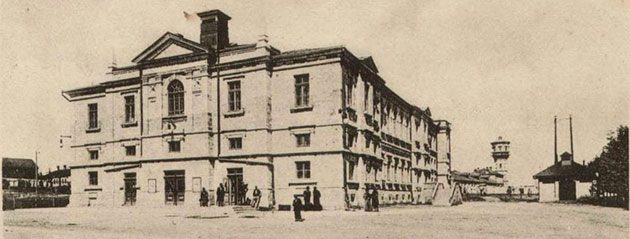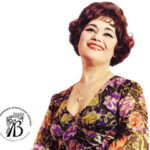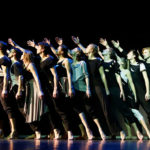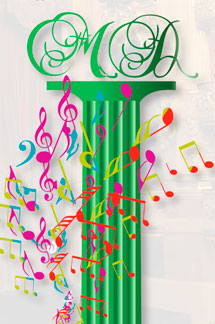Театр «Пушкинская аудитория» прочно вошел в историю Кишинева, хотя само здание не сохранилось. И если проводить экскурсию, то туристам придется показывать корпус госуниверситета, что на углу улиц Пушкина и Матеевич, где и располагался знаменитый когда-то театр, и фотографии столетней давности. Виноват в уничтожении памятника культуры и архитектуры не какой-либо политик или алчный бизнесмен, как это часто бывает, и даже не война, а пожар в 1925 году. Поджег это был, или случайное возгорание, теперь уже не установить. Но «погорелый театр» восстанавливать – увы – не стали.

Карл Шмидт — Кишиневский городской голова, при котором была построена «Пушкинская аудитория»
В 1900 году, когда была построена «Пушкинская аудитория», в Кишиневе существовал только один крупный зал для массовых мероприятий – «Благородное собрание» (много позже значительно перестроенное в кинотеатр «Патрия»). Этого было мало для большого для того времени города. Кроме того, «Пушкинская аудитория», в отличие от «Благородного собрания», устраивавшего и балы, и показы кино, и т.д., была ориентирована только на выступление местных и заезжих театральных артистов.
«Две театральные залы, одна в Пушкинской аудитории, другая при Благородном собрании, давали возможность Кишиневу иметь не только постоянную драматическую труппу, но и предоставлять помещение одесским и прочим гастролерам, никогда не обходившим нас при своих поездках по юго-западу России» — так писал князь Сергей Дмитриевич Урусов, Бессарабский губернатор 1903-1904 гг., в своих «Записках». Уж он-то был частым посетителем «Пушкинской аудитории».
Спроектировал новый театр архитектор Михаил Чекеруль-Куш (его авторству принадлежит здание современного Органного зала). Это было огромное строение, в котором размещался не только внушительный зрительный зал, но и гримерные, и другие необходимые для театра помещения. Прямо у нового театра останавливалась конка, а когда в 1913 году этот вид транспорта перешел на электрическую тягу, то до «Пушкинской аудитории» добирались на тогдашнем чуде техники – трамвае. И хотя «Пушкинская аудитория» располагалась на окраине города (улица Матеевич была границей одной из сторон Кишинева, за ней – поля и редкие виллы), ее полюбили кишиневцы, и зал всегда был переполненным.
Еще бы! Ведь кроме местной труппы, здесь выступали самые именитые артисты того времени, — те, что ковали историю мирового театрального искусства. В газете «Бессарабские губернские ведомости» за 1902 год (декабрь) я нахожу отчет о гастролях известной актрисы Комиссаржевской, выступавшей в «Пушкинской аудитории».
Правда, отчет носил больше финансовый характер: «Г-жа Комиссаржевская, закончившая здесь 6 декабря (по старому стилю – прим.авт.) свои гастроли, взяла с кишиневцев за 6 спектаклей 6100 руб. или 1017 р. на круг и, следовательно, жаловаться на холодный прием в Кишиневе не может. На прощанье, публика поднесла ей роскошный букет живых цветов и ценный подарок – брильянтовое с рубинами кольцо, ценностью около 300 руб. Отсюда г-жа Комиссаржевская выехала в Петербург, где 26 декабря (по старому стилю – прим.авт.) она выступит в «Монне Ванне» с г.Дальским». Кстати, Комиссаржевская со своим театром еще не раз приезжала на гастроли в Кишинев, вплоть до 1910 года. Видно, прием, действительно показался именитой актрисе теплым.
Почти сразу после открытия театра два года на его сцене давала спектакли труппа из Таганрога В.Фокарти, в репертуаре которой были постановки по произведениям Шекспира, Гоголя, Толстого, Достоевского, Чехова, Ибсена и др. Затем, в течение трех лет, в «Пушкинской аудитории» работала труппа Х. Петросяна. Ее полюбили за спектакли по пьесам Горького: «Мещане», «На дне», «Дачники», «Дети солнца». В 1908, 1910 и 1911 на сцене Пушкинской аудитории выступает знаменитая М. Савина, в 1908, 1910, 1913 – В. Давыдов, в 1911 и 1915 – К. Варламов, в 1915 – П. Орленев.
 Но… зрелищ, видно, хватало, а вот с хлебом не у всех было благополучно. Так, «Пушкинская аудитория» прославилась и как очаг революционных волнений. Во время спектакля «Дачники» 11 января 1905 года недовольные жизнью при царе зрители начали вместо «браво» кричать: «Долой самодержавие!», «Да здравствует революция» и тому подобное. Спектакль был сорван. А чуть позже с театральными службами в здании начал соседствовать Союз Русского народа.
Но… зрелищ, видно, хватало, а вот с хлебом не у всех было благополучно. Так, «Пушкинская аудитория» прославилась и как очаг революционных волнений. Во время спектакля «Дачники» 11 января 1905 года недовольные жизнью при царе зрители начали вместо «браво» кричать: «Долой самодержавие!», «Да здравствует революция» и тому подобное. Спектакль был сорван. А чуть позже с театральными службами в здании начал соседствовать Союз Русского народа.
Связано это здание с именем еще одного знаменитого кишиневского архитектора – Владимира Цыганко. Именно он открыл митинг рабочих-строителей в «Пушкинской аудитории» 19 декабря 1905 года. Народа в тот день в театр набилось много – более тысячи человек, ведь решались важные для рабочего люда вопросы: распределение денежной помощи, которую собрали бессарабские инженеры и архитекторы, и создание профсоюза. Денежная помощь была необходима, так как рядовые строители переживали тогда трудные времена, они и обратились к своему «начальству». Те собрали из своих личных средств 2000 рублей – сумма по тем временам огромная. Рабочие в своем письме «богатым» намекали, что, если не разрешить проблему их нищенского состояния, то в городе могут возникнуть беспорядки. Еще до письма строители пытались решить проблему «мирным» путем: обращались в банки за ссудой, но финансовые учреждения им отказали. Тогда Цыганко – об этом он объявил в своей приветственной речи 19 декабря 1905 года – обратился к городскому голове и губернатору с просьбой выделить из казны 6-8 тысяч рублей для выдачи ссуд рабочим. Губернатор обещал помочь, и связаться с министром внутренних дел России, который должен был удовлетворить ходатайство или отказать рабочим. В своей речи Владимир Цыганко предложил рабочим составить списки наиболее нуждающихся и передать их инженеру Левандовскому, который и возьмется за распределение помощи.
Современный молдавский отраслевой профсоюз знает об этом собрании и отсчитывает историю своей организации именно от 1905 года. Силами строителей на Центральном кладбище (в народе – Армянское) были приведены в порядок захоронения Владимира Цыганко и его родных – матери и сына Николая.
Вот так «Пушкинская аудитория» вошла в историю: для кого-то — как центр театрального искусства, для кого-то – как центр профсоюзного и революционного движения. Но думаю, для большинства кишиневцев это несуществующее сегодня здание – просто интересная часть истории любимого города!
Наталья Синявская
Romanian version
Auditoriul Puşkin: teatrul dramelor şi a acţiunilor revoluţionare
Teatrul „Auditoriul Puşkin” ocupă un loc important în istoria Chişinăului, cu toate că clădirea acestuia nu s-a păstrat deloc. Şi dacă se va merge într-o excursie la faţa locului, turiştii vor putea vedea doar clădirea Universităţii de Stat, care se află la intersecţia străzilor Puşkin şi Mateevici, locul unde cîndva era situat faimosul teatru. Adevărata vină pentru distrugera acestui monument istoric şi arhitectonic nu-i aparţine unui oarecare politician sau businessman, cum deseori se întîmplă, şi nici războiului — în 1925 teatrul a fost distrus de un incendiu. Şi nu se ştie dacă a fost intenţionat sau s-a produs întîmplător, nu vom mai afla vre-o dată. Dar nici restabilit după incendiu, cu părere de rău, nu a mai fost.
În anul 1900, cînd cînd a fost construit „Auditoriul Puşkin”, în Chişinău era o singură sală suficient de mare pentru activităţi culturale în masă şi se numea «Casă a Nobilimii»(după mai mult timp reconstruită în cinematograful „Patria” ). Un singur loc de divertisment era prea puţin pentru un oraş mare, cum era Chişinăul în acele timpuri. Plus la toate, „Auditoriul Puşkin”, spre deosebire de «Casa Nobilimii», care pe lîngă altele organiza diverse baluri, reprezentaţii cinematografice, era destinat numai spectacolelor jucate de actori locali şi veniţi din străinătate. „Două săli de teatru, una la „Auditoriul Puşkin”, alta la „Casa Nobilimii”, oferea posibilitate Chişinăului nu numai de a avea o trupă dramatică permanentă, dar şi să ofere loc pe scenă pentru trupe venite din Odesa şi alte localităţi, care neapărat ne vizitau în timpul turneelor în sud-estul Rusiei”- aşa scria în memorialele sale cneazul Serghei Dmitrievici Urusov, guvernatorul Basarabiei în an. 1903-1904.
Noul teatru a fost proiectat de arhitectorul Mihail Checheruli-Cush (tot el este autorul cladirii, unde în prezent se află Sala cu Orgă). Aceasta era o clădire imensă, care găzduia nu numai o sala impunătoare pentru spectatori, dar şi o mulţime de încăperi necesare teatrului. Drept în faţa clădirii se opreau trnsporturi ecvestre, iar cînd în 1913 acest transport a trecut la tracţiune electrică, doritori se deplasau spre teatru cu tramvaiul, care era pe atunci o adevărată minune. Necătînd la faptul, că „Auditoriul Puşkin” era situat la marginea oraşului (strada Mateevici era unul din hotarele oraşului, după care nu mai era nimic în afară de cîmpuri şi cîteva vile), era locul preferat al chişinăuienilor, iar sala întotdeauna arhiplină.
Şi nu e de mirare! În afară de trupele locale pe scenă îşi făceau apariţia adevărate celebrităţi ale acelor timpuri, artişti care au contribuit mult la dezvoltărea artei teatrale în general. În ziarul „Bessarabskie gubernskie vedomosti” din 1902 (decembrie) am găsit o dare de seamă privind turneul actoriţei Comissarjevscaia, care şi-a făcut apariţia pe scena teatrului „Auditoriul Puşkin”. De fapt, darea de seamă mai degrabă este una de ordin financiar: „D-na Comissarjevscaia, terminînd aici pe 6 decembrie (stil vechi-rem.aut.) turneul său, a luat de la chişinăuieni 6100 ruble pentru 6 spectacole sau 1017 ruble pentru fiecare şi, prin urmare, nu se poate plînge că e primită cu răceală la Chişinău. La despărţire, publicul i-a înmînat un buchet somptuos din flori vii şi un cadou preţios – un inel cu diamant şi rubini în valoare de aproximativ 300 ruble. De aici D-na Comissarjevscaia a plecat la Petersburg, unde pe 26 decembrie (stil vechi-rem.aut.) va juca la „Monne Vanne” cu d-l Dalschi”. Printre altele, Comissarjevscaia cu teatrul său a efectuat mai multe turnee la Chişinău, aproape pînă în anul 1910. Se vede că faimoasa actoriţa într-adevăr a fost primită aici cu multă căldură.
Aproape imediat după deschiderea teatrului şi timp de doi ani pe scena lui era prezentă trupa lui V. Focarti din Taganrog, repertoriul cărora conţinea înscenări ale operelor lui Shakespear, Gogol, Tolstoi, Dostoevschi, Cehov, Ibsen şi alţii. După ei, timp de trei ani, pe scena teatrului a evoluat trupa lui H. Petrosean. Aceştea erau adoraţi de spectatori pentru spectacolele puse în scenă după piesele lui M. Gorchi: „Micii burghezi”,”Azilul de noapte”,”Vilegiaturistii”,”Copiii soarelui”. În anii 1908, 1910 şi 1911 în teatru îşi desfăşoară activitatea faimoasa M. Savina, în anii 1908, 1910, 1913 – V. Davîdov, în 1911 şi 1915 – C. Varlamov, în 1915 – P. Olenev.
După cum se vede, programe de divertisment erau suficiente, dar cu pîinea, din păcate, nu toţi o duceau bine. Astfel „Auditoriul Puşkin”a deveni cunoscut şi ca focar al tulburărilor revoluţionare. La 11 ianuarie 1905, în timpul spectacolului ”Vilegiaturistii”, spectatorii nemulţumiţi de viaţă au început în loc de “bravo” să scandeze: “Jos autocraţia!”, “Trăiască revoluţia!” şi aşa mai departe. Spectacolul a fost întrerupt definitiv.
Clădirea teatrului se asociază şi cu un alt arhitect din Chişinău – Vladimir Ţiganco. Anume el, la 19 decembrie 1905 în incinta teatrului a pornit mitingul muncitorilor de la construcţii. Lume în teatru s-a adunat o mulţime – mai mult de zece mii de oameni, lucru firesc, deoarece erau puse în dezbatere întrebări importante pentru muncitori: repartizarea ajutorului financiar, care a fost adunat de ingineri şi arhitecţi basarabeni, şi crearea sindicatului. Ajutorul financiar era necesar, deoarece constructorii de rînd trăiau atunci timpuri grele şi unica soluţie era să se adreseze patronilor. Aceştea din fonduri proprii au adunat 2000 de ruble – bani grei pe acele timpuri. Muncitorii le-au dat de înţeles prin scrisori celor „bogaţi”, că dacă problema sărăciei nu va fi soluţionată, în oraş se vor începe tulburări de ordine. Încă pînă a recurge la scrisori, muncitorii au încercat în mod „paşnic” să-şi rezolve problemele adresîndu-se după împrumuturi la bănci, dar au fost refuzaţi. Atunci Ţiganco, în cuvîntarea ţinută la 19 decembrie 1905, s-a adresat guvernatorului şi primarului oraşenesc cu rugămintea de a aloca din fondul bugetar 6-8 mii de ruble pentru a acorda împrumuturi muncitorilor. Guvernatorul a promis că va contribui la soluţionarea problemei şi că va face legătura cu ministrul de interne al Rusiei, care urma să primească decizia finală. În cuvîntarea sa Vladimir Ţiganco le-a propus muncitorilor să întocmească lista celor mai nevoiaşi şi să le transmită inginerului Levandovschi, care se va ocupa de repartizarea ajutorului.
Actualul sindicat moldovenesc de profil cunoaşte istoia acestei adunări şi nu întîmplător îşi numără începutul anume din 1905. Cu forţele zidarilor la cimitirul din centrul oraşului (în popor numit — Armenesc) au fost aranjate mormintele lui Vladimir Ţiganco şi a apropiaţilor săi – mama şi feciorul său Nicolai.
Astfel „Auditoriul Puşkin” a intrat în istorie: pentru unii ca lăcaş a artei teatrale, iar pentru alţii ca simbol sindical şi al mişcării revoluţionare. Dar cred, că pentru majoritatea locuitorilor oraşului Chişinău această clădire inexistentă în prezent este doar o mică dar captivantă parte din istoria oraşului iubit!
Natalia Sineavscaia
English version
Pushkin’s Auditorium: Theatre of Drama and Revolutions
“Pushkin’s Auditorium” Theatre has entered the history of Chisinau, although the building itself has not been preserved. And should one guide a sightseeing tour, one will have to show the tourists the building of the State University at Pushkin And Mateevici Street where the once famous theatre was located. The narrative could be accompanied by 100-year old photographs. The cultural and architectural monument was demolished not by a politician or greedy businessman, as it is often the case, and even not wars, but the fire of 1925. It is impossible to state by now whether the building was set on fire deliberately or the ignition happened by chance. However, unfortunately it was decided not to rebuild the “burnt-down” theatre.
In the year 1900 when “Pushkin’s Auditorium” was constructed Chisinau saw just one large hall for mass events – “Noble Assembly” (which was many years after reconstructed into “Partia” cinema). The existence of only one hall was insufficient for a large town according to the standards of the past. Besides, “Pushkin’s Auditorium”, in contrast to “Noble Assembly” to organise balls and demonstration of cinema, was meant just for performance of local and foreign theatre artists. “Two theatre halls, one in “Pushkin’s Auditorium” and the other in “Noble Assembly”, provides the city with the possibility not only to keep a standing company of drama actors, but rent the premises for actors from Odessa and other towns touring across South-West of Russia,” according to the “Notes” of Sergei Urusov, The Governor General of Bessarabia in the span 1903-1904. He himself paid frequent visits to “Pushkin’s Auditorium”.
The new theatre was designed by architect Mihail Cereculi-Cus (the other project of his is the building of the modern Organ Hall). This was a huge building to host not only a spacious hall, but also dressing rooms and other premises necessary for a theatre to function. The station of horse-driven tram was right by the entrance into the new theatre, and when in 1913 this transportation means was transferred for electricity drive, one could get to “Pushkin’s Auditorium” by the technical miracle of those times – tram. And although “Pushkin’s Auditorium” was located at the outskirts of the city (Mateevici Street was one of the boundary of Chisinau those times, with fields and rare houses behind it), it was a dear place for the residents of Chisinau and the hall was always full.
And this is clear! Apart of the local artists, the stage saw the performance of the most acclaimed artists of those times – the one that determined the history of the world theatre art of the epoch. The newspaper “Bessarabia Province News” for the year 1902 (December) printed the report on tour of a famous actress Komissarjevskaya who used to perform at “Pushkin’s Auditorium”. Although, the report was more of financial character: “Ms. Komissarjevskaya, who closed here her tour on December 6 (according to Julian calendar – note of author), presented in Chisinau 6 plays to earn 6100 rubbles or 1017 rubbles per play and hence there is no need to complaint about cool reception in Chisinau. At the close of performance the audience presented the actress a luxury bouquet of flowers and a precious gift – a ring with diamonds and ruby worth about 300 rubbles. From Chisinau Ms. Komissarjevskaya left for St. Petersburg, where on December 26 (according to Julian calendar – note of author) she is going to perform the play “Monna Vanna” with Mr. Dalsky”. Apropos, Ms. Komissarjevskaya with her theatre used to pay rather frequent visits to Chisinau until the year 1910. Obviously, the actress considered the reception cordial.
Almost immediately after opening of the theatre, its stages hosted the company of actors conducted by Fokarti from Taganrog for two years in a row, whose repertoire included the plays of Shakespeare, Gogol, Tolstoy, Dostoevsky, Chekhov, Isben and others. Afterwards, in the course of three years “Pushkin’s Auditorium” received the company of actors conducted by Petrosyan. It performed the plays of Gorky: “Petty Bourgeois”, “On the bottom”, “Children of the Sun”, “Villagers”. In the years 1908, 1910 and 1911 the stage of “Pushkin’s Auditorium” was entered by famous Savina; in the years 1908, 1910, 1913 – Davidov, in 1911 and 1915 – by Varlamov, in 1915 – by Orlenev.
Yet… circuses we had, yet bread must be insufficient for all. Thus, “Pushkin’s Auditorium” became notorious as a hearth of revolutionary upheaval. During the pay “Villagers”on January 11th 1905 being dissatisfied with subsistence under the Tsar, the spectators instead of “bravo” shouting: “Down with autocracy!”, “Hurray revolution” and the like. The play was interrupted. While a bit later the theatre administration was neighboring with the Union of Russian People.
This building is also linked with the name of one more famous architect from Chisinau – Vladimir Tiganco. Namely this personality presided at the meeting of workers-builders at “Pushkin’s Auditorium” on December 19th 1905. The theatre was agglomerated those days – more than one thousand of people gathered to decide upon meaningful issues for working class: allocation of monetary compensation collected by engineers and architects from Bessarabia and establishment of trade unions. Monetary compensation was necessary as ordinary builders were experiencing hard times and so they approached their directors. The latter collected 2000 rubbles from their personal means – the sum was enormous for those times. The workers in their letter to “the rich” hinted that should they fail to resolve the problem of their miserable subsistence, they would organize upheaval in the city. Prior to composing the letter the builders tried to resolve the problem through “peaceful” means: they approached the bank for the loan, yet financial institutions declined the petition. Then Tiganco – announcing about his intentions in his greeting speech on December 19th 1905 – addressed the city governor with the request to issue 6-8 thousand of rubbles from the city treasury in order to allot loans to the workers. The Governor promised to help and got in contact with the Minister of Internal Affairs of Russia, who was to satisfy or decline the petition of the workers. In his speech Vladimir Tiganco offered the workers to make up the lists of people in most need and to hand them out to engineer Levandovsky in charge for distribution of the aid.
The present Moldovan trade union is aware about he meeting and counts its history back namely since the year 1905. The workers have voluntary reconstructed the tombs of Vladimir Tiganco, his mother and son Nikolai at the Central Cemetery.
So is the history of “Pushkin’s Auditorium”: for someone this is the centre of theatrical art while for someone else this is the centre of trade union and revolutionary movement. Yet, in my opinion, for the majority of residents of Chisinau this is just a captivating story from the past of the native city!
Natalia Sineavscaia














